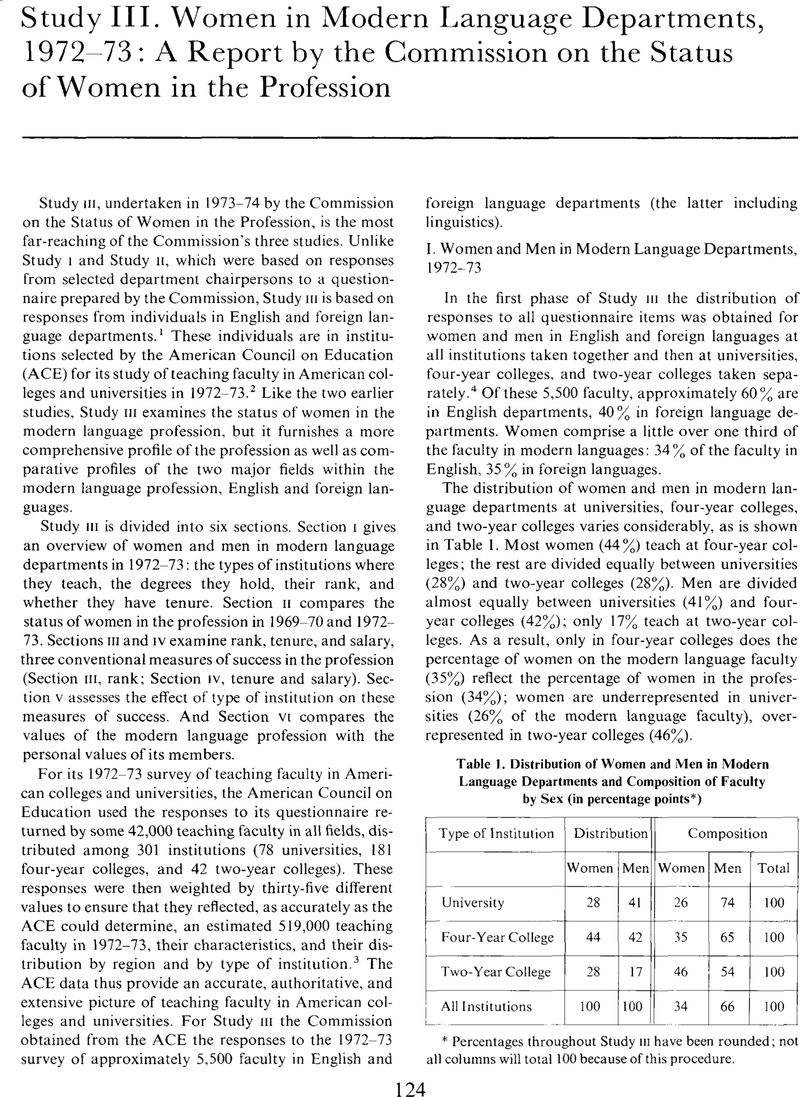Article contents
Study III. Women in Modern Language Departments, 1972–73: A Report by the Commission on the Status of Women in the Profession
Published online by Cambridge University Press: 01 December 2020
Abstract

- Type
- Letter
- Information
- Copyright
- Copyright © Modern Language Association of America, 1976
References
Notes
1 Study i, “The Status of Women in Modern Language Departments,” PMLA, 86 (1971), 459–68; Study ii, “Affirmative Action for Women in 1971,” PMLA, 87 (1972), 530–40.
2 Alan E. Bayer, Teaching Faculty in Academe: 1972–73 (ACE Research Reports, Aug. 1973); Bayer, “College Faculties: ‘Le Plus ça change …,‘ ” Change, 6 (March 1974), 49–50, 63–64; Bayer and Helen S. Astin, “Sex Differentials in the Academic Reward System,” Science, 188 (23 May 1975), 796–802.
3 The data were weighted in order to correct for differences in response rates by type of degree, region, and institution.
4 The results of the first phase of Study m are contained in a 62-page document, which may be obtained from the Commission (at 62 Fifth Ave., New York, N. Y. 10011) for $10, to cover the cost of reproduction and mailing.
5 The source of these statistics is Earned Degrees Conferred; see ADFL Bulletin, 6 (Sept. 1974), 17, for the percentages of women awarded Ph.D.'s in each foreign language and in linguistics during this most recent 5-year period.
6 This loss of 1% is compatible with the slight gain of .9%, reported by Bayer for women in all fields between the ACE 1968–69 survey and the 1972–73 survey.
7 None of these differences in the proportion of women at each rank between 1969–70 and 1972–73 are statistically significant. All tests were performed using the chi-square test of independence and the .05 level of significance.
8 Carnegie Commission on Higher Education, Opportunities for Women in Higher Education: Their Current Participation, Prospects for the Future, and Recommendations for Action (New York: McGraw-Hill, 1973), p. 6. “It will take until about the year 2000,” the Carnegie Commission predicts, “under reasonable assumptions, before women are likely to be included in the national professoriate in approximately the same proportions as they are in the total labor force—this is a task for a generation of effort.” The Carnegie Commission's prediction, gloomy as it sounds, may be optimistic for modern languages in view of these comparative statistics.
9 Sex differences in the distribution of women and men by rank are statistically significant (p < .001 ) at each degree level for both time periods. Changes in the rank distribution from 1969–70 to 1972–73 are also significant (p<.001) at each degree level for both women and men. All tests were performed using the chi-square test of independence.
10 In the 1972–73 data, a larger percentage of women than men failed to respond to the salary question: 16% and 4% of professors, 13% and 2% of associate professors, and 8% and 2% of assistant professors.
11 Coding Key
Highest degree held (1 = no Ph.D. or equivalent; 2 = Ph.D. or equivalent)
Type of school (1 = university; 2 = four-year; 3 = two-year)
Interrupted career (1 = no; 2 = yes)
Time status (1 = full-time; … ; 4 = less than half-time)
Married (1 = no; 2 = yes)
Have dependent children (1 = no; 2 = yes)
Research university (1 = yes; 2 = no)
Social life with colleagues (1 = no; 2 = yes)
Engaged in research (1 = no ; 2 = yes)
Race of institution (1 = predominantly white; 2 = predominantly black) Ever awarded scholarship (1 = no; 2 = yes)
12 Faculty in all fields are substantially older than faculty in ours; only 6% of the men and 11% of the women in the total ACE saniple are under thirty. The modern language field thus constitutes an exception to the rule, noted by Bayer, that the faculty of American colleges and universities was older in the aggregate in 1972–73 than it was in 1968–69.
13 Joan E. Hartman (English, Staten Island Community Coll., City Univ. of New York), Jean A. Perkins (Dept. of Modern Languages, Swarthmore Coll.), and Adrian Tinsley (English and Dean of William James Coll.) are members of the M LA Commission on the Status of Women in the Profession ; Laura Morlock is in the Dept. of Social Relations, Johns Hopkins Univ. The authors wish to thank Faye Mallitz and Carol Weisman of Johns Hopkins Univ. ; Paula E. Stephan of the Dept. of Economics, School of Business Administration, Georgia State Univ.; and Alan E. Bayer, Director of the Institute for Social Research, Florida State Univ.
- 2
- Cited by




